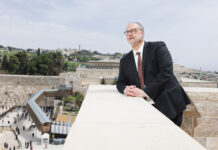Speaking to Mordechai Hager posed a bit of a problem. First, I had three separate hour-long Zoom conversations with him. Then I went to his house in Manhattan with photographer Rami Casper (who happens to be my brother-in-law) to have him review the article and add important information. We spent a total of five hours there, because the longer we stayed, the more incredible stories we heard. And he also shared important life lessons on Torah learning, shalom bayis, bein adam lachaveiro and more. By the time we left, I was faced with a dilemma: I had to decide what to include in this article. It was a difficult task, as Mordechai Hager deserves an entire book.
Every article I write is meant to inspire and uplift, as well as offer practical, implementable advice. I aim to have at least one life-changing idea or concept every week. For Shavuos, I always look for a unique individual who will inspire people to add more learning to their lives. For that I need an accomplished businessman who not only loves Torah, but learns, lives and lifts up others to grow in their Torah learning. Mordechai Hager more than fits the bill.
After starting off working for his father-in-law, Mordechai built a very popular urban fashion brand. Then, after a “lucky” investment, he decided to do it full time. These days, Mordechai is what is known as a unicorn investor, someone who invests in companies worth at least $1 billion. Some of those he invested in at an early stage include Uber, Instacart and Coinbase. Forbes has referred to him as “the man with the Midas touch.”
Nowadays, he runs Regah Ventures together with his son Avi and spends his day analyzing companies and managing his investments.
We spoke about his tips for investing in startups, how to pitch an investor and more business tips. However, speaking about business was just a means to an end—to talk about Torah, and, more specifically, how to inspire others to learn more Torah.
Mordechai had never granted an interview about his personal life before. It was only after hearing about the positive feedback we received from readers after previous Shavuos columns saying how they had been inspire to commit to new sedarim of learning that he agreed.
Mordechai is the author of several sefarim including Simchas Mordechai, which contains many of his conversations with Rav Chaim Kanievsky, zt”l. He has also developed a close relationship with many gedolim, including Rav Dovid Cohen of Flatbush.
He shared his journey of how he began taking his learning more seriously while working. It involves Daf Yomi, and not in the way most people would think. Most importantly, Mordechai’s advice will help you add more learning to your life. Learning that you will love.
A gut Yom Tov to all, and may you celebrate Kabbalas HaTorah in good health and happiness!
–Nesanel
I was born in Antwerp, Belgium. I have a brother and a sister. My brother David is the youngest. He lives in LA and is a big baal chesed, although I only hear about it from others. My sister Leah is married to Avigdor Weingarten, a Gerrer chasid from London. We are a close-knit family and speak at least once a week.
“When I was five, my family moved to Israel and settled in Tel Aviv. My mother was born in Rzeszów, Poland, and her maiden name was Landau; she’s a descendant of the Noda BiYehudah. My father is from Ober Vishoi (Vishova) in Romania. I’m related to the Vizhnitzer rebbes, with whom I share a last name.
“My father was married before WWII and had two kids, but his first wife and children were killed in the Holocaust. After the war he moved to Belgium, where he met and married my mother. After the dust settled, many family members moved to America, but my father had promised that if he survived Auschwitz he would move to Eretz Yisrael. This was before the founding of the state. So we moved to Eretz Yisrael.
“My father got together with a few Belgians and founded an ice cream company, which eventually became very famous. It was called Artik. It became so famous that today it’s the generic name in Israel for ice pops on a stick.
“I went to Rav Amiel’s yeshivah in Tel Aviv. In those days you had two choices in Israel: either go to a yeshivah that offered no secular education, or go to a high school with little Torah learning. A regular high school is a four-year program, but the one I went to was a five-year program because it combined a high level of Torah learning with secular subjects. But I only finished four years because I was afraid of failing the Bagrut exam. I wanted to go to college, but I also wanted to go to yeshivah, so I went to New York and learned in Torah Vodaas from 1967 until 1970 while simultaneously going to Brooklyn College.
“My rebbe in Torah Vodaas was Rav Eliyahu Chazan. Rav Gedalia Shorr was the rosh yeshivah. I had a unique connection with Rav Schorr because I used to smoke and he would share his cigarettes with me; we were partners in crime.
“I got married in America in 1970 and then went to Columbia Business School. My wife, Lois, is from Brooklyn. Her father was David Wassner, a very kind man and a big baal chesed who was tragically killed at a young age. He was hit by a young man who was driving without a license. I’d like to mention my brother-in-law Lenny Wassner, who inspires me greatly, as he spends maybe 10% of his time in his successful real estate businessman. The rest of the time he spends learning.
“My plans were to go back to Israel and work in my father’s business. But then I ended up really liking it here, so I decided to stay. I didn’t have any specific career goal, so I started working for my father-in-law in the clothing business. I worked my way up from the bottom as a salesman to CEO of one division. We had a great relationship even after I eventually set out on my own path. He was also the president of Maimonides Hospital.
“After ten years of working for him, I decided that I wanted to go out on my own, so I started my own clothing company. One of the first things I did was work on a patent. Have you ever seen a nylon hoodie jacket with a kangaroo pocket in the front? The jacket was designed to fit into that same pouch and was very convenient to carry around. I came up with the idea. It was called Jac A Bag, and we sold millions of them.
“From there I got into urban clothing after learning that there was a great demand for it among African Americans. The company was called Pure Playaz. Then we had another brand called Vocal, a joint venture with a famous singer. We also had a joint venture with a very famous actor who wasn’t Jewish. He was taking classes in ‘Kabbalah’ at that infamous center in LA, and I would get emails from him with gematriyos and everything.
To read more, subscribe to Ami





















